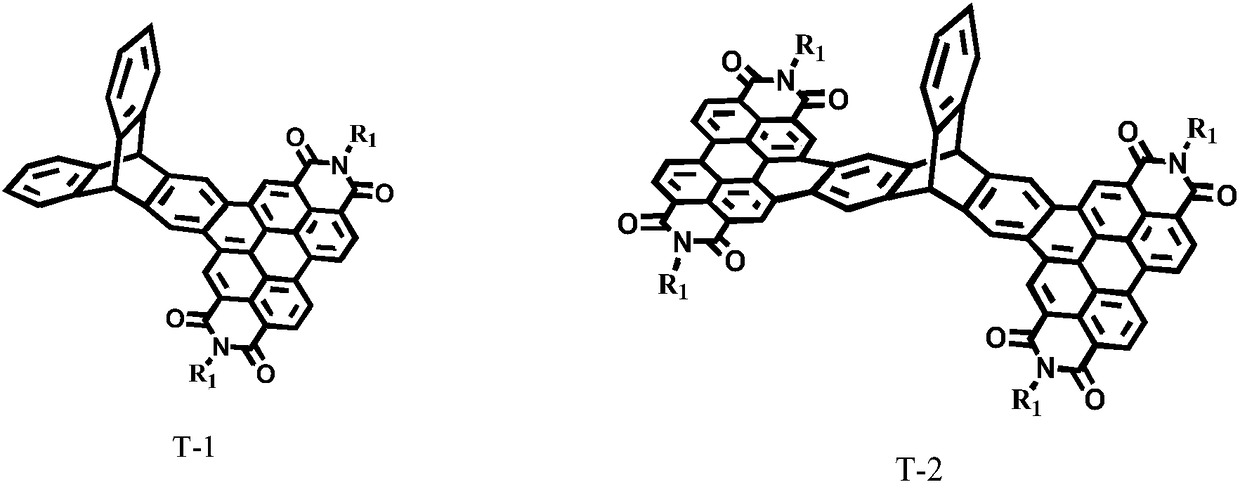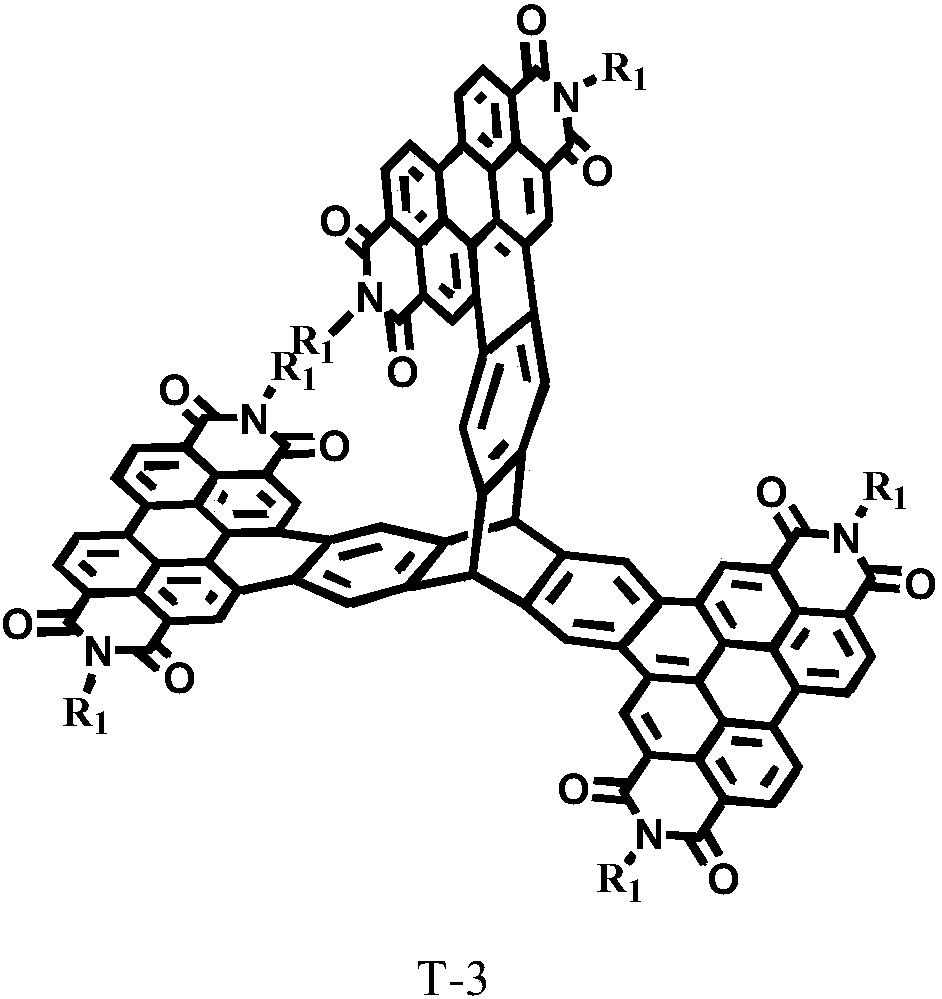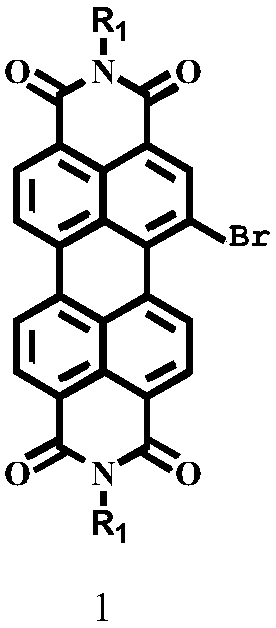Synthesis and preparation method and applications of triptycene-based perylene imide compound
A technology of peryleneimide and tripterene, which is applied in the field of organic photovoltaic materials and can solve problems that have not been reported
- Summary
- Abstract
- Description
- Claims
- Application Information
AI Technical Summary
Problems solved by technology
Method used
Image
Examples
Embodiment 1
[0064] Embodiment 1, the preparation of target product T-1-1
[0065] (1) Preparation of intermediate 1-1
[0066] In a sealed glass tube, add monobromoperyleneimide (Formula 1) (275mg, 0.395mmol), tripterene monoboronate (Formula 2-1) (100mg, 0.263mmol), THF 8ml and 2M sodium carbonate Aqueous solution 4ml. The mixture was sparged with argon for 30 min. Tetrakis(triphenylphosphine)palladium (36 mg, 0.032 mmol) was then added under argon. The mixture was heated to reflux for 48h, then cooled to room temperature, 25ml of water was added, extracted with dichloromethane (2×25ml), dried over anhydrous magnesium sulfate, filtered with suction, and the solvent was removed. The crude product was purified by chromatographic column to obtain a red solid, namely Intermediate 1-1 (225 mg, 90%). The reaction equation is as follows:
[0067]
[0068] The structural confirmation data of intermediate 1-1 are as follows: 1 H NMR (500MHz, C 2 D. 2 Cl 4 ,373.2K)δ=8.70-8.60(m,4H),8.5...
Embodiment 2
[0073] Embodiment 2, the preparation of target product T-2-1
[0074] (1) Preparation of intermediate 2-1
[0075]In a sealed glass tube, add monobromoperyleneimide (Formula 1) (345mg, 0.494mmol), tripterene bisborate (Formula 2-2) (100mg, 0.198mmol), 8ml of THF and 2M sodium carbonate Aqueous solution 4ml. The mixture was sparged with argon for 30 min. Tetrakis(triphenylphosphine)palladium (27 mg, 0.024 mmol) was then added under argon. The mixture was heated to reflux for 48h, then cooled to room temperature, 25ml of water was added, extracted with dichloromethane (2×25ml), dried over anhydrous magnesium sulfate, filtered with suction, and the solvent was removed. The crude product was purified by chromatographic column to obtain an orange solid (284mg , 87%), namely intermediate 2-1. The reaction equation is as follows:
[0076]
[0077] The structural confirmation data of intermediate 2-1 are as follows: 1 H NMR (500MHz, C 2 D. 2 Cl 4 ,373.2K)δ=8.71-8.58(m,10H)...
Embodiment 3
[0082] Embodiment 3, the preparation of target product T-3-1
[0083] (1) Preparation of intermediate 3-1
[0084] In a sealed glass tube, add monobromoperyleneimide (Formula 1) (353mg, 0.506mmol), triptene triborate (Formula 2-3) (100mg, 0.158mmol), tetrahydrofuran 8ml and 2M sodium carbonate Aqueous solution 4ml. The mixture was sparged with argon for 30 min. Tetrakis(triphenylphosphine)palladium (25 mg, 0.019 mmol) was then added under argon. The mixture was heated to reflux for 48h, then cooled to room temperature, 25ml of water was added, extracted with dichloromethane (2×25ml), dried over anhydrous magnesium sulfate, filtered with suction, and the solvent was removed. The crude product was purified by chromatographic column to obtain an orange solid (315mg , 85%), namely intermediate 3-1. The reaction equation is as follows:
[0085]
[0086] The structural confirmation data of intermediate 3-1 are as follows: 1 H NMR (500MHz, C 2 D. 2 Cl 4 ,373.2K)δ=8.73-8.6...
PUM
| Property | Measurement | Unit |
|---|---|---|
| Short circuit current | aaaaa | aaaaa |
Abstract
Description
Claims
Application Information
 Login to View More
Login to View More - R&D
- Intellectual Property
- Life Sciences
- Materials
- Tech Scout
- Unparalleled Data Quality
- Higher Quality Content
- 60% Fewer Hallucinations
Browse by: Latest US Patents, China's latest patents, Technical Efficacy Thesaurus, Application Domain, Technology Topic, Popular Technical Reports.
© 2025 PatSnap. All rights reserved.Legal|Privacy policy|Modern Slavery Act Transparency Statement|Sitemap|About US| Contact US: help@patsnap.com



